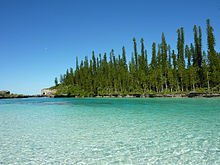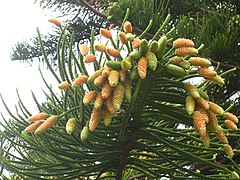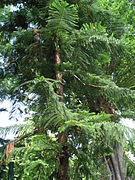Araucaria columnaris
| Araucaria columnaris | |
|---|---|

| |
| Scientific classification | |
| Kingdom: | Plantae |
| Clade: | Tracheophytes |
| (unranked): | Gymnosperms |
| Division: | Pinophyta |
| Class: | Pinopsida |
| Order: | Pinales |
| Family: | Araucariaceae |
| Genus: | Araucaria |
| Section: | A. sect. Eutacta |
| Species: | A. columnaris
|
| Binomial name | |
| Araucaria columnaris J.R.Forst. Hook.
| |
| Synonyms[2] | |
| |
Araucaria columnaris, the coral reef araucaria, Cook pine (or Cook's pine), New Caledonia pine, Cook araucaria, or columnar araucaria, is a species of conifer in the family Araucariaceae.
Distribution[]
The tree is endemic to New Caledonia in the Melanesia region of the Pacific.
It was first classified by Johann Reinhold Forster, a botanist on the second voyage of Captain James Cook to circumnavigate the globe as far south as possible.
Description[]
Araucaria columnaris is a distinctive narrowly conical tree growing up to 60 m (200 ft) tall in its native habit. The trees have a slender, spire-like crown.[3] The shape of young trees strongly resembles A. heterophylla. The bark of the Cook pine peels off in thin paper-like sheets or strips and is rough, grey, and resinous.[3]
The relatively short, mostly horizontal branches are in whorls around the slender, upright to slightly leaning trunk. The branches are lined with cord-like, horizontal branchlets. The branchlets are covered with small, green, incurved, point-tipped, spirally arranged, overlapping leaves. The young leaves are needle-like, while the broader adult leaves are triangular and scale-like.[3]
The female seed cones are scaly, egg-shaped, and 10–15 cm (4–6 in) long by 7–11 cm (3–4 in) wide. The smaller, more numerous male pollen cones are at the tips of the branchlets and are scaly, foxtail-shaped, and 5 cm (2 inches) long.[3]
A 2017 study found that trees tend to have a uniform tilt dependent on the hemisphere of their location, leaning on average 8 degrees south in the northern hemisphere and the same angle north in the southern hemisphere.[4]
Ornamental tree[]
It is cultivated in gardens and public landscapes in Queensland and Victoria of Australia, northern New Zealand, Southern California, Puerto Rico, Mexico, India, Philippines and Hawaii.[3]

Male cones

Foliage
References[]
- ^ Thomas, P. (2010). "Araucaria columnaris". IUCN Red List of Threatened Species. 2010: e.T42196A10661112. doi:10.2305/IUCN.UK.2010-2.RLTS.T42196A10661112.en. Retrieved 14 November 2021.
- ^ "Araucaria columnaris (G.Forst.) Hook.". World Checklist of Selected Plant Families (WCSP). Royal Botanic Gardens, Kew. Retrieved 13 December 2017 – via The Plant List.
- ^ a b c d e "Araucaria columnaris". The Gymnosperm Database.
- ^ Johns, J. W.; Yost, J. M.; Nicolle, D.; Igic, B.; Ritter, M. K. (2017). "Worldwide hemisphere-dependent lean in Cook pines". Ecology. 98 (9): 2482–2484. doi:10.1002/ecy.1850. PMID 28556968.
External links[]
| Wikimedia Commons has media related to Araucaria columnaris. |
- Endemia.NewCaledonia — Araucaria columnaris — distribution maps & text info.
- Conifers.org: Araucaria columnaris (coral reef araucaria) — description & images.
- Foster Garden (Honolulu, Hawai'i) — Araucaria columnaris image].
- University of Murcia.es: World Plants virtual gallery photos of Araucaria columnaris
- IUCN Red List least concern species
- Araucaria
- Endemic flora of New Caledonia
- Trees of New Caledonia
- Least concern flora of Oceania
- Taxa named by Johann Reinhold Forster
- Taxa named by William Jackson Hooker
- Garden plants of Oceania
- Ornamental trees


